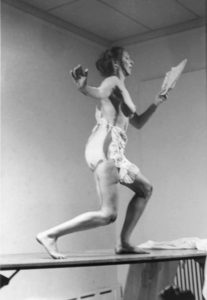OPEN ASSEMBLY
Experiments in Aesthetics and Politics









































Feminine Failures: The Radical Possibilities of Punk’s Subversion of Gender and Capital
The numerous subcultures of the 20th century are routinely credited for serving as a reflection of society while simultaneously negating social normativity. There is perhaps no subcultural population that has sought so vehemently to disengage with normative forms and revel in social disapproval than punks. Although “punk” is often relegated to music, fashion, and other common identifiers of a youth-driven subculture, the term can encompass a wide range of expressions, practices, and modes of being.
In a recent lecture held at the ICA Los Angeles entitled Last Gasp or Future Possibility? Punk, Visual Anarchy, and DIY, artist and scholar Rachel Garfield suggests that punk is not so much a revolutionary force, but a signifying gesture against existing structures of capitalism and traditional forms of gender expression. Pointing primarily to non-male artists and musicians, Garfield endorses the potentialities of punk as an alternative mode of art-making, free of the confines of male-dominated, financialized institutions. This form of art-making is contingent on a DIY practice, one that relies solely on what is accessible to the artist and not on what can be afforded only through costly, inaccessible, and elite art institutions. Thus, the DIY, or “do it yourself” convention of punk is not only a practical and accessible alternative to the traditional art world but an act of resistance against the hegemony and normativity of these spaces.
Throughout the lecture, Garfield reflects on the work of punk female artists and musicians of the 1970s, whose contentious relationship with financialized art institutions was further complicated by the implications of gender expression in both normative social conditions and in their own subcultural milieu. Traditional art spaces, whether they be galleries, museums, art schools, artist studios, or the art market at large, are reliant upon and perpetuate systems of capital. Therefore, the artists who participate in the art world are at the whim of capitalistic interest, and in some way must express a capitalistic ambition in order to succeed, at least in a traditional sense. This restrictive system is also highly visible in a patriarchal society where success is predicated upon preexisting conditions of gender expression. The social expectations of capitalist ambition are likened to social expectations for traditional gender expression, as both are established upon a patriarchal system of normativity and oppression.
The quantification of feminine success is measured by a male standard. Thus, a refusal to comply with this standard is, what Garfield refers to as, a “feminine failure” that potentially imparts new freedoms to the women who elect to “fail”. A failure to succeed in capital through the practice of DIY and the failure of femininity through a negation of feminine appearance, behavior, or other gender conventions ultimately represent the essence of punk. British punk artists such as Poly Styrene of the band X-Ray Spex and Siouxsie Sioux of Siouxsie and the Banshees expressed their dissenting attitudes towards repressive capitalistic and gender systems through their personal style and performance. These artists rejected traditional modes of feminine beauty and normative behavior by embracing the categorical opposite of traditional femininity. Punk, beyond music genre or subculture, facilitates an epistemological break from the existing structures of gender and capital, where the aim is not to succeed but to be unassailable.

Poly Styrene of X-Ray Spex
This negation of gender and capital through punk DIY is highly visible in the work of fringe female filmmakers and performance artists of the 1970s. The 1970s signified what Garfield calls the “last gasp” of an authentic moment outside capitalistic ambition that pre-dated the contentious battle over art funding that characterized the 1980s as an era of censorship. However, these funding bodies, even ones dedicated to marginalized and experimental artists, were still subject to the same hierarchical structures and valorization of wealth that systemically excluded artists who lacked the capital required to access these institutions. The financialized aspects of art making, by way of funding, gallery spaces, studios, and more, directly inform the residual assumptions of what constitutes art and how and what should be historically canonized. Garfield argues that film captures the tension between art as social transformation and art in service to the bourgeoisie during a “last gasp” decade.
The “do it yourself” sensibility of punk, specifically DIY art making and filmmaking, directly foregrounds the anti-establishment, anti-bourgeois notion that anyone, especially those cast out or excluded from the mainstream, can create something significant. This DIY aesthetic reflects both what occurs behind the camera and in front of it, embodying a distinct tone that necessitates the ugliness, cheapness, and grittiness that would otherwise be rejected in traditional art-making conventions. In conjuring a distinctly punk DIY aesthetic, I think of films such as the 1978 cult classic Jubilee, which technically and aesthetically reflects the writer/director Derek Jarman’s independence from traditional filmmaking institutions or funding bodies. The casting of non-actors and filming in low-income London neighborhoods, for example, are some of the DIY conventions that define the film’s aesthetic. In this sense, films like Jubilee succeed because of their independence and low budget, not in spite of it.

A still from Jubilee (1978)
This subversive spirit is precisely where punk’s negation of capital, feminism, and art-making converge into a distinct aesthetic form. The specific character of the punk aesthetic could perhaps be described as an aesthetic of failure. Garfield emphasizes how female artists and filmmakers faced additional obstacles in accessing support or funding, which makes the punk DIY practice not only an aesthetic choice but a vital decision for the survival of their art practice. The defiant cheapness, ugliness, messiness, and vulgarity that characterizes the works of female filmmakers and visual artists, such as Vivienne Dick, Carolee Schneeman, and Abigail Child, is important. These techniques demonstrate the DIY punk aesthetic as an aesthetic of failure. The failure speaks to being divorced from capitalistic ambition and resisting traditional femininity as they are translated into the work itself. Complicating the issue, the DIY aesthetic is not necessarily a byproduct of an artist’s inability to access elite art spaces. Yet, its distinctive style is the result of a choice, a conscious withdrawal from a standardization that diminishes non-normative work, particularly that of non-male, non-white, artists.
Carolee Schneemann’s 1975 landmark performance “Interior Scroll” vehemently embraces the aesthetics of failure. In the performance, a white sheet-clad Schneeman ascends a dining table and briefly reads from her book Cezanne, She Was A Great Painter. Upon abandoning the reading, the artist enacts a series of poses before disrobing and squatting over the table. Schneemann then pulls the titular scroll from her vagina and reads its context out loud to a packed audience. The scroll’s contents are a dialogue between the artist and American art critic Annette Michelson, who allegedly refused to watch Schneeman’s films. During the performance, Schneemann reads: “I met a happy man a structuralist filmmaker – but don’t call me that it’s something else I do – he said we are fond of you you are charming but don’t ask us to look at your films” and “Pay attention to critical and practical film language it exists for and in only one gender”.
This provocative performance demonstrates the shift away from the hegemonic, male-dominated precedent of the female body in art, particularly the female nude. In “Interior Scroll”, Schneeman refused to divorce her art-making from her sexuality. This allows her to foreground the body of the artist as both a source of knowledge and the subject and “architecture” of the work. By maintaining control over the explicitly sexual attributes of her work, Schneeman negates patriarchal standards of femininity and normative sexual expression. She does this in part by confronting Michelson’s attempt to apply the standards of canonized work against Schneemann and refusing to engage with or legitimize Schneeman’s films as a critic. This conflict allows Scheneeman to engage with the tension between art making as an act of social transformation and as a service to the bourgeois art world. The key tool for aiding her intervention is wielding her feminine failure as a mode of resistance.

Carolee Schneemann performing “Interior Scroll” (1975)
While Schneeman is an artist who, for all intents and purposes, bridged the gap between subversive art-making practices and the traditional art world, there were and remain innumerable artists who cannot and will not access these spaces. To further represent the DIY conventions of the punk ethos, Garfield utilizes the collage in both a literal and metaphorical sense. Collage-making requires little to no access to materials, funding, or traditional art spaces. Anyone and everyone can participate in collage-making, and the legitimization of this medium supports artists who might be otherwise ostracized. Garfield describes collaging and similar art forms as eliciting a “kitchen table aesthetic.” In both a literal sense, artists can forgo a conventional studio in favor of a kitchen table or similar space. In a metaphorical sense, these works also reflect the low-tech, DIY atmosphere in which they were created. DIY artists can then reject traditional art spaces, whether it be an institution, studio, gallery, or museum. In sum, it showcases a de facto form of resistance to capital and patriarchy. More conceptually, we can take punk to be a sort of culture of “cutting up.” Like the cutting up of material in fashion or art, both the cutting up or distortion of sound in punk music, as well as the cutting up of existing systems and forms to deconstruct societal conventions and rebuild anew.
While Garfield’s text and lecture effectively link the subversion of capital and subversion of gender to the DIY punk subculture, there are some essential elements that are seemingly neglected. I believe it is important to acknowledge that artists who seek out alternative modes of creation or curation can still be privileged to certain access points in the art world. Artists like Carolee Schneeman, who embody this subversive, DIY approach to art-making, were routinely afforded opportunities in the presentation of their art that are not divorced from capitalism. This does not negate the revolutionary nature of the punk artists cited by Garfield, but the notion that DIY is inherently punk or that punks are defined by a DIY aesthetic does not account for nuances in art’s intersectionality. This reduction is also evident in the approach to the “female artist” as if to suggest the “female” identifier preconditions the artist and artmaking. Retrospectively, this gender-based designation seems to not only encapsulate female-identifying artists to the specific genre of “feminist art”, but neglects non-female identifying artists who meaningfully subvert gender and capital through their work. Perhaps, what further discourse on punk’s subversion of capital necessitates is first a thorough examination of what punk is. Although I believe Garfield’s work is more of an attempt to capture punk’s essence than define its epistemology, the ambiguous evocation of “punk” leaves many questions and considerations unanswered.
Outside the DIY punk framework, I agree with Garfield’s assertion that failure to succeed in femininity and capitalism welcomes an alternative mode of being, one free from the constraints of hegemonic, patriarchal institutions. The innate DIY conventions of punk, and conversely, the inherent punk-ness of the act of DIY celebrates this failure and upholds the notion of anti-normativity that characterizes this subculture. In the subsequent global scale of late capitalism, as it stands today, an authentic moment outside of capitalism appears not only unattainable but entirely inconceivable. However, the preservation of this aesthetic of failure, one that can be achieved through the active flattening of hierarchy and embracing of heterogeneity, imparts a potentiality of a sustained last gasp of hope.